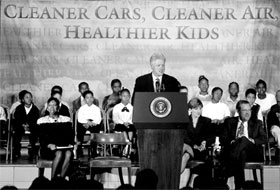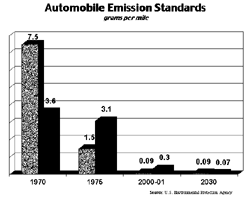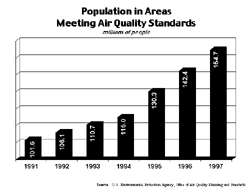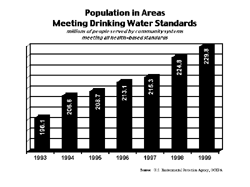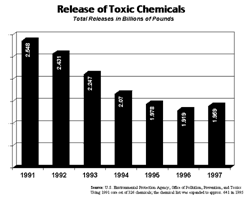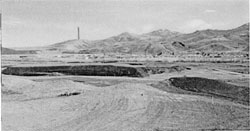
|
|||||||||||||||||||||||||||||||||||||||||||||||||||||||||||||||||||||||||||||||||||||||||
|
Clean Air, Safe Water, Healthy Communities
President Clinton and Vice President Gore have launched a new generation of environmental and public health protections to continue this progress and to meet new challenges unforeseen in 1970. Under their leadership, the Administration has adopted the toughest clean air standards ever; strengthened drinking water protections; accelerated toxic waste cleanups; expanded our communities' right to know about toxic releases; and taken special steps against environmental health risks to children. Together, these measures are helping to move America closer to the day when we can fulfill every citizens' right to clean air, safer water, and a healthy neighborhood. Cleaning Up Auto Emissions Last December, President Clinton took the boldest steps in a generation to improve air quality and protect public health by reducing pollution from cars and other vehicles.
When fully implemented, these measures will result in cars that are 77 percent cleaner and light-duty trucks that are up to 95 percent cleaner than those on the road today — the equivalent of removing 164 million cars from the road. Improved air quality will prevent up to 4,300 premature deaths and 173,000 cases of childhood respiratory illness each year. Tough Standards for Soot and Smog
Safeguarding our Drinking Water
Accelerating Toxic Waste Cleanups
Strengthening the Public's Right to Know
The Administration has nearly doubled the number of chemicals subject to reporting, and expanded by 30 percent the number of facilities that must report. Last year, reporting requirements were strengthened for 27 "persistent bioaccumulative" chemicals like mercury, dioxin, and PCBs, which are especially risky because they do not break down easily and are known to accumulate in the human body. In addition, the Administration forged a partnership with the chemical industry and the environmental community to develop better data on the potential health effects of the 2,800 most widely used chemicals. Ensuring Clean Waters Across America President Clinton launched a major Clean Water Action Plan in 1998 to help fulfill the promise of the Clean Water Act — clean, healthy water for all Americans. To help clean up the almost 40 percent of America's surveyed waterways still too polluted for fishing and swimming, the plan targets the largest remaining threats to water quality: polluted runoff from farms and city streets. The five-year plan encourages community-based cleanup strategies and provides new resources to states, local governments, and landowners to help implement them. Over the past two years, the President has secured $3.9 billion to implement the plan.
Making Children's Health a Priority Children are particularly vulnerable to environmental health threats. Their bodies are still developing. Pound for pound, they eat, drink, and breathe more than adults. And their play puts them in close contact with the environment. President Clinton signed an Executive Order in 1997 to ensure that these added risk factors are closely scrutinized. The order directs agencies to coordinate their research priorities on children's health, and to ensure that health and safety standards they adopt take into account special risks to children. The Administration has launched outreach campaigns to educate parents, teachers, and health providers about environmental health risks to children. And, to develop better science, the Administration has awarded grants to nine universities to establish children's environmental health research centers. Improving Food Safety Standards To ensure that America's food supply remains among the safest in the world, the Administration has made reducing food-borne illness a national priority. New steps include improved safety standards for meat, poultry, and seafood products, as well as for fruit and vegetable juices. Research, education, and surveillance efforts also have been greatly expanded. In 1996, President Clinton signed the landmark Food Quality Protection Act, setting strict new standards for pesticide residues in food — including the first pesticide standards aimed specifically at protecting children. The Administration is on track to completing reviews for the pesticides posing the greatest potential risk by the end of this year. Ending Childhood Lead Poisoning Despite bans on lead-based paint and lead in gasoline, lead remains one of the greatest environmental health threats to children. Nearly one million children under six — one in 20 — have elevated levels of lead in their bodies, posing a risk of serious nervous system disorders such as reduced intelligence, reading and learning disabilities, and behavior problems. Through grants that help state and local governments identify and remove lead-based paint in older, privately owned, low-income housing, where hazards are most prevalent, the Administration has helped make over 25,000 homes lead-safe. Earlier this year, the Administration launched a new strategy with an ambitious goal of eliminating childhood lead poisoning in America in 10 years. The Administration's proposed budget for the coming year includes $164.5 million to begin implementing this new strategy.
Camp Verde, Arizona When the people of Camp Verde, Arizona, discovered high levels of naturally occurring arsenic in their drinking water, they knew they had a problem: Too much arsenic can lead to cancer, diabetes, and other health problems. But when Camp Verde set out to upgrade its water system, it encountered a second problem: It discovered that financing wasn't readily available for smaller water systems. That changed in 1996, with the creation of the Drinking Water State Revolving Fund, which provides low-interest loans to communities to make their water systems safer and more reliable. In 1998, Camp Verde received a $1.3 million loan, enabling the city to install a pipeline to a new, safer water source. "As a result of this program, we now provide safer drinking water to over 2,000 people," said Stan Bullard, vice president of the Camp Verde Water System. "We would not have gotten this far without the Drinking Water State Revolving Fund."
Richmond, California Concerned about high rates of cancer and other disease in their largely minority community, concerned residents in Richmond, California, decided to take a closer look at toxic releases from a nearby oil refinery and other industrial plants.
Although the cause of the high cancer rates remains unresolved, the report helped lead to a dialogue with Chevron, which agreed in 1994 to close down older portions of its plant and install pollution prevention equipment to achieve zero net emissions from a new reformulated fuel project. "TRI was essential in providing information, for the first time, on Chevron's emissions," said Henry Clark of the West County Toxics Coalition. "We use the TRI information to gauge whether companies are interested in actually reducing emissions. A good company is committed to making these reductions. Without that information, we would have no clue as to whether their emissions are going up or down. The information allowed us to be able to negotiate with them on emissions reductions."
Anaconda, Montana
A century earlier, the site had contained one of the world's largest copper smelters. But long after the smelter closed and the mining jobs disappeared, the land remained gouged with mines, laced with heavy metals, and littered with slag heaps. Working with the local community and with ARCO, the property's owner, the Environmental Protection Agency helped develop a plan to clean up the contamination, restore the landscape, and return it to productive use. Apart from the golf course, the project included a new hiking trail and restoration of a nearby trout stream. The golf course has proven to be a tourist magnet, spurring higher property values and other business investments, and helping Anaconda transform itself into a popular vacation spot. "It was nothing but a wasteland," Anaconda resident Rose Nyman told the local paper. "For those of us who saw the transformation, it's just been incredible. No one would believe what it was and what it has become."
Milwaukee, Wisconsin The sudden hospitalization of a two-year-old boy named Cher awakened Hmong families in Milwaukee to the very real dangers of lead poisoning — and to the government assistance that has helped make their homes safer and their community stronger. Like many other immigrants, many Hmongs who have come to the United States from their native Laos have settled in aging, low-income housing unaware of the threat from peeling lead-based paint. When Cher became sick and a doctor suspected lead poisoning, tests revealed a lead level in his body many times higher than levels known to impair cognitive function, stunt growth, and cause behavioral difficulties. Cher was immediately hospitalized and the Milwaukee Health Department, through a program supported by the Department of Housing and Urban Development, brought in a skilled contractor to make his home lead-safe. The Health Department and HUD then worked with the Hmong American Friendship Association to educate the Hmong community about the dangers of lead and to set up a program that dispatches crews to remove lead hazards from homes. The program also trains members of the community to work in the crews as certified lead abatement technicians. "We learned about the real risk of lead poisoning that our mothers and children face in the older homes that are available in our community," said Lo Neng Kiatoukaysy, the association's executive director. "We have turned dangerous unrecognized lead hazards into opportunities to unify our community, make real change in the lives of children and families, and offer training jobs that teach valuable skills to our under- and unemployed youth while they earn a paycheck."
To comment on this service, |
|||||||||||||||||||||||||||||||||||||||||||||||||||||||||||||||||||||||||||||||||||||||||
